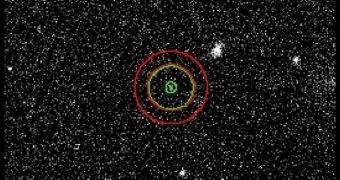In a paper to be published in an upcoming issue of the esteemed Astronomical Journal, experts describe the tracking efforts undertaken to study two newly found Jovian moons, which were first identified during routine observations of the gas giant in 2010.
The objects are very small. In fact, one of them is the smallest known satellite orbiting Jupiter, at a diameter of just 2 kilometers (1.2 miles). They received the MPC designations S/2010 J 1 and S/2010 J 2, on June 1, 2011.
Since September 2010, when the moons were first identified, astronomers have conducted a series of other studies on the objects, seeking to confirm their existence several times. The effort to do so is detailed in the upcoming paper.
Interestingly, the finding is not that important for understanding Jupiter's satellite system. The planet is now listed as having 67 bodies orbiting it, although many more have remained undetected to this day. Analyzing the newly found bodies is more of an exercise for astronomers.
The first, S/2010 J 1, was discovered by astronomers at the NASA Jet Propulsion Laboratory and the University of British Columbia, on September 7-8, 2010. The first images of this body were taken using the 200-inch Hale Telescope at the Palomar Observatory.
The 3.6-meter Canada–France–Hawaii Telescope's (CFHT) MegaCam instrument discovered the second moon, S/2010 J 2, on September 8. The team behind the work was led by CFHT Executive Director Christian Veillet, Astrobiology Magazine reports.
“It was exciting to realise that this [S/2010 J 2] is the smallest moon in the Solar System that was discovered and tracked from Earth,” explains Mike Alexandersenn, from the University of British Columbia (UBC) Department of Physics and Astronomy.
Both moons are believed to have formed as a result of ancient collisions between Jupiter and large comets. This idea is strengthened by the fact that several of Jupiter's moons appear to be clustered together in families, indicating they have the same origin, or formed through the same mechanisms.
S/2010 J 2 is now cataloged as Jupiter's faintest satellite. This explains why a series of studies conducted in 2003 could not see this object. Conversely, S/2010 J 1 was seen at that time, but astronomers could not confirm their finding with the available technologies.

 14 DAY TRIAL //
14 DAY TRIAL //